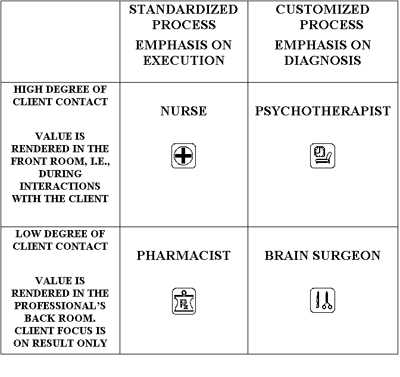How "personal" should your personal service be?





by Tony Vidler ![]()
![]()
![]()
 It is our livelihood in many respects, yet one of the vaguest phrases we use is “personal service”. What is a personal service is not necessarily the same as a personalised service, and what is personal to one client may not be deemed a personal service to another.
It is our livelihood in many respects, yet one of the vaguest phrases we use is “personal service”. What is a personal service is not necessarily the same as a personalised service, and what is personal to one client may not be deemed a personal service to another.
So how personalised should your professional services offer be, taking into account the types of clients you work with (and the varied expectations of different demographics and niches), and the type of work you do? In other words, how much customization should go into your personal service promise, and how much should be standardised?
Well, if we take a look at the structural differences – or service offers – of another profession it can help us to understand what might be possible for our financial services practices.
The medical profession consists of many different specialists and practitioners or carers with celarly defined skills sets and responsibilities. Generally their skill sets or areas of responsibility define the service offer they provide, and the degree of personal “service” that their clients can expect. In many professional services fields however, a practitioners area of expertise doesn’t define the value they provide quite so readily. We can begin to think about the service offering we might provide though by looking at the medical profession as it does have clarity around where each professional sits in the value chain.

It is immediately apparent that a high level of standardisation in service delivery makes sense when the focus of the discipline is upon immediate delivery of a treatment. Conversely, a far higher level of customisation or personalisation is required and expected when treatment is bespoke and requiring more advanced skills or knowledge to be able to deliver the a service effectively.
A further layer of consideration is the expectation of the customer. Within this example, a client of a nurse in an emergency room will expect a higher degree of “personal” attention than the same client does when they visit the pharmacist afterwards to have the prescription fulfilled for ongoing treatment. Make no mistake: both professionals have a role to play in this process for the client. Both can kill. Both can cure. Full treament requires both on many occasions.
However the pharmacist has an extremely limited relationship with the client. Theirs is typically a transactional relationship only. An order is fulfilled. It is critical that the order is fulfilled precisely, and there is zero tolerance for error in doing so. Both the nurse and the pharmacist will rely heavily upon standardised processes wherever possible to minimise risk to the client, and maximise the possibility of correct treatment being administered. Anyone who has had a stint in hospital will know what I mean: you get fed up with telling everyone your date of birth and full name, right? That’s standardised service – everyone follows the process, and everyone gets the process delivered to them whether they want it or not.
This is not the case however when the emphasis of the professional is upon detailed diagnosis which is unique to the client. The client experience is more personalised – although the client experience with the surgeon (who they will actually barely talk to) is almost entirely focussed upon achieving a specified result. It is a rather dispassionate process focussed upon the result rather then the person called a patient.
The process with a psychotherapist is hardly dispassionate or aloof though. That is eminently personal and requires a trusted relationship which evolves. The psychotherapist follows a process, however there is inherently more flexibility and personalisation within that process than there is with the surgeon.
If we were to think about a professional services firm in the same context then it follows that the degree of “personal service” we should provide would be largely dictated by:
It is possible to cater to both ends of the spectrum (100% standardised as well as 100% bespoke), and I encourage profesisonals to consider building a practice which does so. There is typically room for both with a client base, given there will be clients who are in a transactional/execution-only mindset (perhaps because of the stage of life or circumstances), and there wil be those who require our version of psychotherapy.
There is also a distinct possibility that a practitioner might fit into multiple boxes. For instance the diagram could easily have the titles substituted as follows:
Nurse = Insurance Broker
Pharmacist = Mortgage Broker
Psychotherapist = Financial Planner
Brain Surgeon = Estate Planner
It is conceivable that a practitioner who was say a financial planner who also provided mortgage broking services could have a highly standardised, execution-focussed, broking service whilst also having a high-touch and highly bespoke financial planning service for those clients wanting long term personal planning.
Each practice and each practitiioner will have their own view of what personal service is – and so too do clients of course. In the bid to develope a profitable practice where there is minimal waste and a homogeneous client experience though we should begin by identifying those services or clients where standardization of service delivery is optimal – for us as well as for the clients. Fully customised personal service should be reserved for those with the desire and the budget to fund it.
Defining which activities and elements of advice or service fit into the standardized version and which are reserved for customised service experiences is the challenge which each practitioner must resolve to their own satisfaction.
Comments (4)